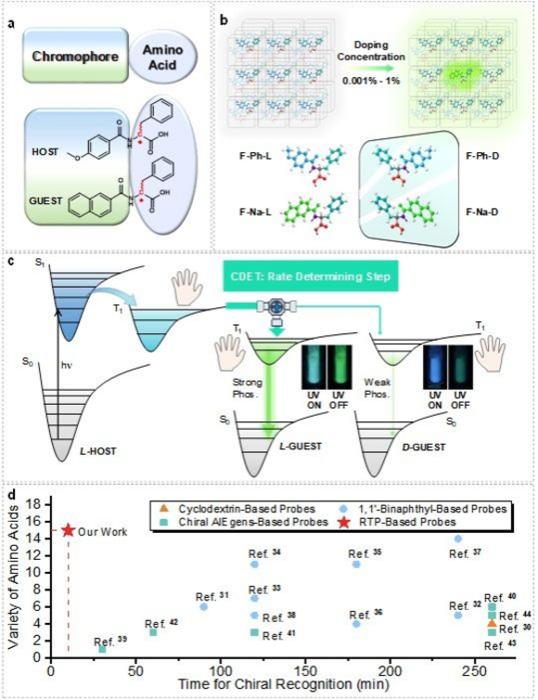A research team led by Prof ZHANG Guoqing from the University of Science and Technology of China (USTC) of the Chinese Academy of Sciences (CAS) presented a novel molecular-solid sensor that enables rapid chiral recognition of natural amino acids through room-temperature phosphorescence (RTP), overcoming the limitations of structural complementarity and generality in traditional luminescence-based methods. Their findings were published in Nature Communications.

Credit: ZHANG Guoqing et.al
A research team led by Prof ZHANG Guoqing from the University of Science and Technology of China (USTC) of the Chinese Academy of Sciences (CAS) presented a novel molecular-solid sensor that enables rapid chiral recognition of natural amino acids through room-temperature phosphorescence (RTP), overcoming the limitations of structural complementarity and generality in traditional luminescence-based methods. Their findings were published in Nature Communications.
Guest-host-doped RTP systems have made significant advancements in applications of various fields, including next-generation optoelectronics, high-contrast bioimaging, and chiral recognition. With increasing attention on the design of RTP systems with chiral moieties, understanding the relationship between structure and property has become crucial. Leveraging the essential role of chirality in natural evolution, exploring richer spectral methods to understand the correlation between molecular chirality, excited states, and electron spin will elucidate fundamental principles and drive innovative technological transformations.
In their earlier work in 2023, Prof. Zhang’s team first discovered and named the chiral-selective phosphorescence enhancement (CPE) phenomenon, revealing the chirality-dependency of energy transfer between molecules (Nat. Commun., 14, 1514 (2023)). In this study, they proposed a more universal sensing scheme allowing for rapid chiral recognition of RTP. They discovered that amino acids react with highly reactive 2-naphthoyl chloride under mild conditions, forming chiral energy acceptors. This process sensitizes the generation of RTP in a triplet energy donor medium. At the same time, L-phenylalanine derivative serves as universal triplet energy donors, providing advantages in mass production and purification.
The team initially confirmed the feasibility of modular design in CPE systems. Experimental results showed that, under different doping ratios, the fluorescence enhancement factors were relatively low, ranging from 1.6 to 3.2. However, under the same conditions, the enhancement factors of RTP spectra significantly increased. This difference is attributed to the fact that guest fluorescence can occur through both Förster and Dexter energy transfer, while guest RTP is limited to Dexter energy transfer.
Furthermore, the optimal preparation method was determined by comparing the spectral intensity ratios under different preparation methods, and a screening of all 15 natural amino acids and their unnatural enantiomers was conducted based on the established scheme. The results showed that this method has the widest applicability among all published luminescent chiral sensing systems, with recognition times as short as a few minutes.
Finally, by introducing heavy atoms (e.g., bromine) to modulate molecular structure and enhance the radiation transition rate of guest molecules, better phosphorescence enhancement effects were achieved. This result demonstrates the possibility of optimizing molecular structures under the guidance of CPE principles to obtain better recognition conditions, showcasing the advantages of organic RTP sensing recognition.
Journal
Nature Communications
DOI
10.1038/s41467-024-47648-z
Article Title
Xiaoyu Chen, Renlong Zhu, Baicheng Zhang, Xiaolong Zhang, Aoyuan Cheng, Hongping Liu, Ruiying Gao, Xuepeng Zhang, Biao Chen, Shuji Ye, Jun Jiang & Guoqing Zhang Nature Communications volume 15, Article number: 3314 (2024) Cite this article 1878 Accesses 31 Altmetric Metrics details Abstract Chiral recognition of amino acids is very important in both chemical and life sciences. Although chiral recognition with luminescence has many advantages such as being inexpensive, it is usually slow and la
Article Publication Date
17-Apr-2024




